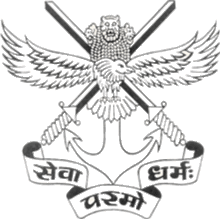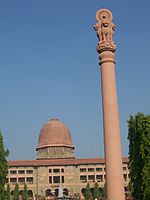- National Defence Academy
-
For other uses, see National Defence Academy (disambiguation).
National Defence Academy 
Motto सेवा परमो धर्म: Motto in English Service Before Self Established 7 December 1954 Type Military Academy Commandant Lieutenant General Jatinder Singh Location Khadakwasla, Maharashtra, India Campus 7,015 acres (28.39 km2) Colors Maroon[1]
Affiliations Jawaharlal Nehru University Website nda.nic.in The National Defence Academy is a Joint Services academy of the Indian Armed Forces, where cadets of the three services, the Army, the Navy and the Air Force are trained together before they go on to pre-commissioning training to their respective service academies. It is located in Khadakwasla near Pune, Maharashtra.
NDA alumni have led and fought in every major conflict in which the India Army has been called to action since the academy was established. The alumni include 3 Param Vir Chakra recipients and 9 Ashoka Chakra recipients.
Contents
History
In 1941, Lord Linlithgow, then Governor-General of India received a gift of a hundred thousand pounds from a grateful Sudanese Government towards building a war memorial in recognition of the sacrifices of Indian troops in the liberation of Sudan in the East African Campaign during World War II. At the end of the war, Field Marshal Claude Auchinleck, then Commander-in-Chief of the Indian Army, drawing on experiences of the army during the war, led a committee to study various Military academies around the world and submitted a report to the Government of India in December 1946. The committee recommended the establishment of a Joint Services Military Academy, with training modeled on the United States Military Academy at West Point.[2]
After the independence of India in August 1947, the Auchinleck Report was taken up by the Chiefs of Staff Committee in India, which immediately implemented the recommendations. The committee initiated an action plan in late 1947 to commission a permanent defence academy and began the search for a site to build the academy. They also decided to set up an interim training academy, known as the Joint Services Wing (JSW), which was commissioned on 1 January 1949 at the Armed Forces Academy (now known as the Indian Military Academy) in Dehradun. Initially, after two years of training at the JSW, Army cadets went on to the Military wing of the AFA for a further two-year pre-commission training, while the Navy and Air Force cadets were sent to Dartmouth and Cranwell in the United Kingdom for further training.
Following the partition, India's share of the monetary gift received from Sudan, amounted to £ 70,000 (the remaining £ 30,000 of the gift went to Pakistan). The Indian Army decided to use these funds to partly cover the cost of construction of the NDA. The foundation stone for the academy was laid by then Prime Minister of India, Jawaharlal Nehru on 6 October 1949. The National Defence Academy was formally commissioned on 7 December 1954, with an inauguration ceremony held on 16 January 1955.[3] The JSW program was transferred from the AFA to the NDA.
Campus
The NDA campus is located about 17 km south-west of Pune city, north-west of Khadakwasla Lake. It spans 7,015 acres (28.39 km2) of the 8,022 acres (32.46 km2) donated by the Government of the erstwhile Bombay State. The site was chosen for being on a lake shore, the suitability of the neighboring hilly terrain, proximity to the Arabian Sea and other military establishments, an operational air base nearby at Lohegaon as well as the salubrious climate. The existence of an old combined-forces training centre and a disused mock landing ship, HMS Angostura, on the north bank of the Khadakwasla lake which had been used to train troops for amphibious landings, lent additional leverage for the selection of the site.[2] Aptly, NDA is also located in the hunting grounds of the legendary Shivaji, with the Sinhagad Fort as a panoramic backdrop.
The administrative headquarters of the NDA was named the Sudan Block, in honour of the sacrifices of Indian soldiers in the Sudan theatre during the East African Campaign. It was inaugurated by then Ambassador of Sudan to India, Rahmatullah Abdulla, on 30 May 1959. The building is a 3-storeyed basalt and granite structure constructed with Jodhpur red sandstone. It's architecture features an exterior design comprising a blend of arches, pillars and verandahs, topped by a dome. The foyer has white Italian marble flooring and panelling on the interior walls. On the walls of the foyer hang the portraits of NDA graduates who have been honored with the highest gallantry awards, the Param Vir Chakra or the Ashoka Chakra.
A number of war relics adorn the NDA campus, including legendary captured tanks and aircraft.[4] The Vyas Library offers an extensive collection of over 100,000 printed volumes, in addition to numerous electronic subscriptions and a number of periodicals and journals from around the world in at least 10 languages.
Admission
Applicants to the NDA are selected via a written exam conducted by the UPSC, followed by extensive interviews covering general aptitude, psychological testing, team skills as well as physical and social skills, along with medical tests. Incoming classes are accepted twice a year for semesters starting in July and January. About 320,000 applicants appear for each written exam. Typically, about 9,000 of these are invited to interview. Applicants to join the Air Force also go through a Pilot Aptitude Battery Test. About 300-350 cadets are accepted to the academy each semester. About 66 cadets are accepted for the Air Force, 39 for the Navy and 195 for the Army.
Cadets who are accepted and successfully complete the program, are commissioned as officers in their respective Service. A cadet can only decline to accept the commission in case of a serious permanent medical condition caused during the program.[5]
Curriculum
Academics
The NDA offers only a full-time, residential undergraduate program. Cadets are awarded a Baccalaureate degree (a Bachelor of Arts or a Bachelor of Science) after 3 years of study. Cadets have a choice of two streams of study. The Science stream offers studies in Physics, Chemistry, Mathematics and Computer Science. The Humanities (Liberal Arts) stream offers studies in History, Economics, Political Science, Geography and Languages.
In both streams, academic studies are split into three categories of courses.
- In the Compulsory Course, cadets study English, Foreign Languages (Arabic, Chinese, French or Russian), Physics, Chemistry, Mathematics, Computer Science, History, Political Science, Economics and Geography. Note that all cadets must take basic classes in all these subjects except Foreign Languages. Cadets then take advanced classes depending on their chosen stream.
- The Foundation Course is mandatory and comprises Military Studies and General Studies. Subjects such as Military History, Military Geography, Weapons systems and Armaments, etc. are covered in Military Studies. Subjects such as Geopolitics, Human Rights, Laws of Armed Conflict and Environmental Sciences are covered in General Studies.
- The Optional Course focuses on subjects specific to the cadet's chosen Service.
Cadets spend the first four semesters on the Compulsory Course and the Foundation Course. They take the Optional Course during the fifth and sixth semesters. They may transfer to other Service academies for the optional courses.[6]
Training
Training Pattern
All the cadets joining the NDA after their 10+2 Examination, are trained in the Academy for three years culminating into graduation in B.A/B.Sc. or B. Sc. (Computer Science) degree of Jawaharlal Nehru University. Apart from academic training they are also trained in outdoor skills, like Drill, PT and games. The emphasis in NDA is on character building, esprit-de-corps, mental and physical robustness, leadership and a sense of keen observation.
NDA has an excellent infrastructure for all-round training of cadets and vast array of facilities like spacious and well maintained classrooms, well equipped labs, two Olympic size swimming pools, a Gymnasium, 32 football grounds, polo grounds, a cricket stadium and a number of squash and tennis courts. The academic year is divided into two terms, viz. Spring Term (January to May ) and Autumn Term (July to December). Here a cadet has to undergo training for a total of six terms before he passes out from NDA.
Squadrons and Battalions
On reporting to the Academy, a cadet is allotted to one of the 15 Squadrons, which then becomes his home away from home for the next three years. The Squadrons are named as Alpha, Bravo, Charlie, Delta, Echo, Foxtrot, Golf, Hunter, India, Juliet, Kilo, Lima, Mike, November and Oscar. No. 1, No. 2 and No. 3 Battalions have four squadrons each while No. 4 has 3 squadrons. Each squadron has approximately 100 to 120 cadets drawn from senior as well as junior courses under training in the Academy.
A squadron comprising a healthy and eclectic mixture of cadets from diverse backgrounds and varying abilities is a veritable melting pot, where the bonds of camaraderie are forged. The squadron spirit is inculcated and nurtured through the cadet’s stay. The prestigious Inter Squadron Championship Trophy awarded to the best squadron epitomizes the pinnacle of teamwork and team spirit. The champion squadron has the proud tradition of possession of the Champion banner for one term, which is carried during the parade and other sports meets. Each squadron has its own nickname, an individual identity with a richly textured history and mascot. The rudimentary import of the NDA’s motto “Service before Self” is first taught in the environs of the squadron, where a cadet learns the importance of putting the squadron’s requirements well above his own.
Twelve Indian states donated approximately Rs. 5,00,000 each for the construction of the various Squadrons. The following Squadron buildings have been named after the donor states :- 'A' - Madras & Andhra 'B' - Madhya Pradesh 'C' - Maharashtra 'D' - Bihar 'E' - Uttar Pradesh 'F' - Orissa 'G' - Gujarat 'H' - Karnataka 'I' - Punjab 'J' - West Bengal 'K' - Assam 'L' - Bombay
Notable Alumni
Alumni of the academy have led and fought in every major conflict in which India has participated since the academy was established. They have an illustrious record of numerous gallantry awards and achieving the highest offices in the Armed Forces.
Three alumni of the academy have been awarded the Param Vir Chakra.[5]
- Captain Gurbachan Singh Salaria, Posthumous, 1 Gorkha Rifles, Congo, 1961
- 2nd Lieutenant Arun Khetarpal, Posthumous, 17 Poona Horse, Indo-Pakistani War of 1971
- Captain Manoj Kumar Pandey, Posthumous, 11 Gorkha Rifles, Kargil War, 1999
Nine alumni of the academy have been awarded the Ashoka Chakra, as of 2010.
31 alumni have been awarded the Maha Vir Chakra. 152 have been awarded the Vir Chakra.
33 alumni have been awarded the Kirti Chakra. 122 have been awarded the Shaurya Chakra.
8 Chiefs of Army Staff, 7 Chiefs of Naval Staff and 4 Chiefs of Air Staff of the Indian Armed Forces have been NDA alumni.[7]
In the Media
The Standard Bearers, a documentary directed and written by Dipti Bhalla and Kunal Verma provides an inside look the history and operations of the NDA.
See also
- Military academies in India
- Sainik School
- Indian Naval Academy
- Army Cadet College
References
- ^ http://nda.nic.in/html/nda-sacred-symbols.html
- ^ a b http://nda.nic.in/html/nda-history.html
- ^ http://www.bharatonline.com/maharashtra/travel/pune/national-defence-academy.html
- ^ http://www.warbirdsofindia.com/maharashtra/nda-khadakvasla.html
- ^ a b http://indianarmy.nic.in/writereaddata/documents/nda-joining-instruction.pdf
- ^ http://nda.nic.in/html/nda-academic-training.html
- ^ http://nda.nic.in/html/nda-chiefs-of-staff.html
External links
 Military of India Portal ·
Military of India Portal ·  Category (Army · Navy · Air Force · Coast Guard)
Category (Army · Navy · Air Force · Coast Guard)Branches Wars and
conflictsIndo-Pakistani wars of 1947 / 1965 / 1971 · Operation Polo · Operation Vijay · Sino-Indian War · Chola incident · Siachen conflict · Blue Star · Woodrose · 1987 Sino-Indian skirmish · Indian intervention in the Sri Lankan Civil War · Operation Cactus · Kargil War · Kashmir insurgency · 2001 Indian–Bangladeshi border conflict · Operation Parakram · Piracy in SomaliaCategories:- Military academies of India
- Educational institutions established in 1954
- Education in Pune
Wikimedia Foundation. 2010.



